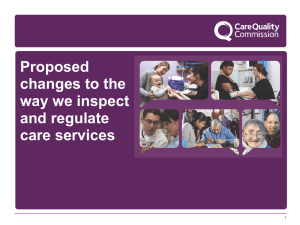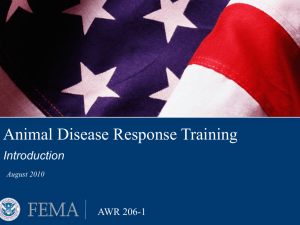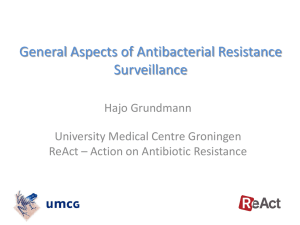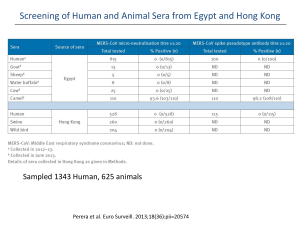State-Based Oral Health Surveillance Systems
advertisement
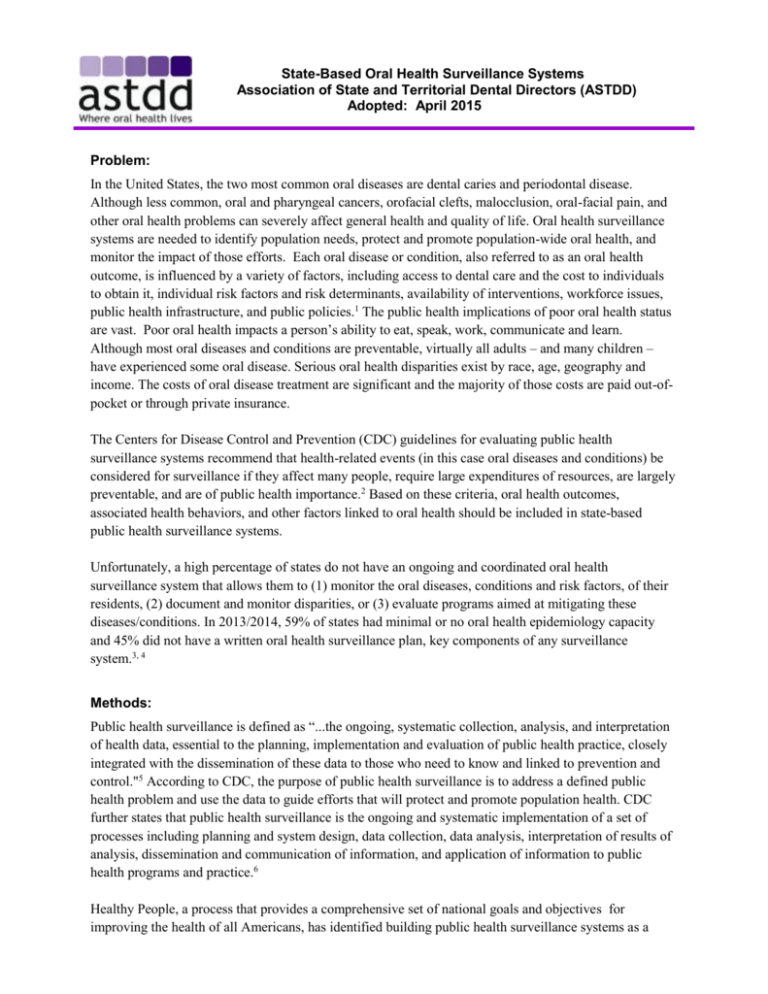
State-Based Oral Health Surveillance Systems Association of State and Territorial Dental Directors (ASTDD) Adopted: April 2015 Problem: In the United States, the two most common oral diseases are dental caries and periodontal disease. Although less common, oral and pharyngeal cancers, orofacial clefts, malocclusion, oral-facial pain, and other oral health problems can severely affect general health and quality of life. Oral health surveillance systems are needed to identify population needs, protect and promote population-wide oral health, and monitor the impact of those efforts. Each oral disease or condition, also referred to as an oral health outcome, is influenced by a variety of factors, including access to dental care and the cost to individuals to obtain it, individual risk factors and risk determinants, availability of interventions, workforce issues, public health infrastructure, and public policies.1 The public health implications of poor oral health status are vast. Poor oral health impacts a person’s ability to eat, speak, work, communicate and learn. Although most oral diseases and conditions are preventable, virtually all adults – and many children – have experienced some oral disease. Serious oral health disparities exist by race, age, geography and income. The costs of oral disease treatment are significant and the majority of those costs are paid out-ofpocket or through private insurance. The Centers for Disease Control and Prevention (CDC) guidelines for evaluating public health surveillance systems recommend that health-related events (in this case oral diseases and conditions) be considered for surveillance if they affect many people, require large expenditures of resources, are largely preventable, and are of public health importance.2 Based on these criteria, oral health outcomes, associated health behaviors, and other factors linked to oral health should be included in state-based public health surveillance systems. Unfortunately, a high percentage of states do not have an ongoing and coordinated oral health surveillance system that allows them to (1) monitor the oral diseases, conditions and risk factors, of their residents, (2) document and monitor disparities, or (3) evaluate programs aimed at mitigating these diseases/conditions. In 2013/2014, 59% of states had minimal or no oral health epidemiology capacity and 45% did not have a written oral health surveillance plan, key components of any surveillance system.3, 4 Methods: Public health surveillance is defined as “...the ongoing, systematic collection, analysis, and interpretation of health data, essential to the planning, implementation and evaluation of public health practice, closely integrated with the dissemination of these data to those who need to know and linked to prevention and control."5 According to CDC, the purpose of public health surveillance is to address a defined public health problem and use the data to guide efforts that will protect and promote population health. CDC further states that public health surveillance is the ongoing and systematic implementation of a set of processes including planning and system design, data collection, data analysis, interpretation of results of analysis, dissemination and communication of information, and application of information to public health programs and practice.6 Healthy People, a process that provides a comprehensive set of national goals and objectives for improving the health of all Americans, has identified building public health surveillance systems as a national goal; therefore, efforts must be made to increase the proportion of states with an oral health surveillance system. The Healthy People 2020 oral health surveillance objective OH-16 is to “Increase the number of States and the District of Columbia that have an oral and craniofacial health surveillance system.” The operational definition for this objective is the number of states and the District of Columbia with surveillance data from at least six of the nine possible surveillance databases with oral health information (i.e., BRFSS, YRBSS, PRAMS/PRAMS-like systems, children’s oral health data meeting NOHSS criteria, ASTDD Synopses, state cancer registry/NCI SEER, orofacial cleft data, Medicaid dental claims data, and WFRS). In 2010, 43 of the 51 jurisdictions met this operational definition.7 Even though the HP2010 goal was not achieved, this represented significant progress, considering that the number of states or District of Columbia having an oral health surveillance system increased from zero in 1999.7 HP2020 continues to target all 50 states and the District of Columbia to have an oral health surveillance system (OH-16). Since Objective OH-16 was developed, however, the public health surveillance framework has been transformed by a variety of external factors: new information technologies, health care reform, new data sources, and an expanded view of what constitutes oral health and adequate oral health surveillance. Public health leaders recognize that oral health surveillance should address a variety of conditions, risk factors and external influences; employ a variety of methods and data sources; and go beyond basic disease reporting. In addition, it must address the overarching purpose of surveillance: providing actionable information to guide public health policy and programs. The transformed public health surveillance framework was acknowledged, documented and addressed when the Council of State and Territorial Epidemiologists (CSTE) published the 2013 whitepaper State-Based Oral Health Surveillance Systems: Conceptual Framework and Operational Definition, and highlighted these concepts.1 The changed healthcare landscape has both increased the need for oral health surveillance data to support decision-making and program evaluation and enhanced the capability of state oral health programs to conduct surveillance. In its 2013 whitepaper, CSTE proposed an enhanced operational definition of a state oral health surveillance system for OH-16 to replace the previous definition. The enhanced definition of a surveillance system is to monitor broad-based oral diseases and conditions, along with strategies associated with oral health outcomes, particularly access to dental care and community water fluoridation. Moreover, it includes an oral health surveillance plan, and timely, public availability of actionable data.1 To support state programs’ oral health surveillance development and enhancement, all state grantees through cooperative agreements under the CDC State-based Oral Disease Prevention Program (for the period of 2013-2018) are required to meet oral health surveillance performance measured by the enhanced operational definition of a state oral health surveillance system proposed for HP2020 objective OH-16.8 CSTE Proposed Operational Definition of State-Based Oral Health Surveillance System for HP2020 OH-16 This operational definition includes a core or foundational set of surveillance elements. States should be encouraged to expand their oral health surveillance system to include a wider variety of indicators based on the needs and resources of the individual state. For a state to be classified as having an oral health surveillance system, it must have all of the following items:1 1. A written oral health surveillance plan that was developed or updated within the previous five years. 2. Oral health status data for a representative sample of third grade children meeting criteria for inclusion in NOHSS. Data must have been collected within the previous five years. 3. Permanent tooth loss data for adults obtained within the previous two years. 2 4. Annual data on oral and pharyngeal cancer incidence and mortality. 5. Annual data on the percent of Medicaid- and CHIP-enrolled children who had a dental visit in the previous year. 6. Data on the percent of children 1-17 years who had a dental visit in the previous year, obtained every four years. 7. Data on the percent of adults (≥18 years) and adults with diabetes who had a dental visit in the previous year, obtained within the previous two years. 8. Data on the fluoridation status of public water systems within the state, updated every two years. 9. Annual data on state oral health programs and the environment in which they operate, including workforce and infrastructure indicators, submitted to the Annual Synopses of State and Territorial Dental Public Health Programs. 10. Publicly available, actionable oral health data to guide public health policy and programs disseminated in a timely manner. This may take the form of an oral disease burden document, publicly available reports, or a web-based interface providing information on the oral health of the state’s population developed or updated within the previous five years. Policy Statement ASTDD supports and strongly recommends that state health jurisdictions develop an oral health surveillance plan, and implement and maintain a robust state-based oral health surveillance system. A surveillance system should monitor oral health status, access to dental care, individual risk factors and risk determinants, availability of interventions, workforce issues, public health infrastructure, and public policies. The surveillance system should include dissemination of timely and actionable publicly available data. At a minimum, a state-based oral health surveillance system should include the ten items identified by CSTE, with expansion to a wider variety of indicators based on the needs and resources of the individual state. __________________________________________________ References 1. Phipps K, Kuthy R, Marianos D, Isman B. State-based oral health surveillance systems: conceptual framework and operational definition. Council of State and Territorial Epidemiologists, Atlanta, GA, 2013. http://c.ymcdn.com/sites/www.cste.org/resource/resmgr/Chronic/StateBasedOralHealthSurveill.pdf. Accessed October 29, 2014. 2. German RR, Lee LM, Horan JM, Milstein RL, Pertowski CA, Waller MN; Guidelines Working Group Centers for Disease Control and Prevention. Updated guidelines for evaluating public health surveillance systems: recommendations from the Guidelines Working Group. MMWR Recomm Rep. 2001;50(RR-13):1-35. 3. Association of State and Territorial Dental Directors. Synopses of State Dental Public Health Programs, Data for FY 20122013. July 2014. 4. Council of State and Territorial Epidemiologists. Epidemiology Capacity Assessment for Chronic Disease, Maternal and Child Health and Oral Health. 2015 (in press). 5. Thacker SB, Berkelman RL. History of public health surveillance. In: Public Health Surveillance, Halperin W, Baker EL (Eds.): New York; Van Norstrand Reinhold, 1992. 6. Hall HI, Correa A, Yoon PW, Braden CR; Centers for Disease Control and Prevention. Lexicon, definitions, and conceptual framework for public health surveillance. MMWR Surveill Summ 2012;61 Suppl:10-4. 7. Centers for Disease Control and Prevention. Data 2010 … the Healthy People 2010 Database. wonder.cdc.gov/data2010/obj.htm. 8. Centers for Disease Control and Prevention. Oral Health Home. State-based Oral Health Programs. CDC-funded States. http://www.cdc.gov/oralhealth/state_programs/cooperative_agreements/index.htm. 3 Acronyms Used in the Policy Statement ASTDD: Association of State and Territorial Dental Directors BRFSS: Behavioral Risk Factor Surveillance System CDC: Centers for Disease Control and Prevention CHIP: Children’s Health Insurance Program CSTE: Council of State and Territorial Epidemiologists HP: Healthy People NCI SEER: National Cancer Institute’s Surveillance Epidemiology and End Results Program NOHSS: National Oral Health Surveillance System PRAMS: Pregnancy Risk Assessment Monitoring System WFRS: Water Fluoridation Reporting System YRBSS: Youth Risk Behavior Surveillance System 4
